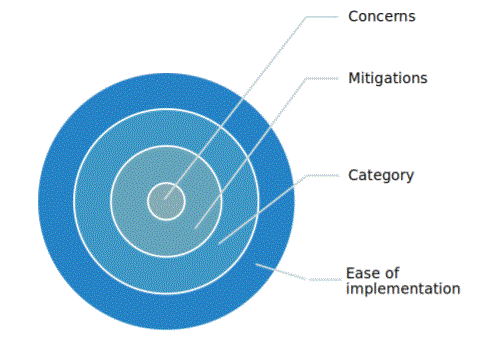Europe’s CORUS-XUAM consortium has published research results addressing the main concerns of society with regard to drone operations. The paper is the result of a series of public surveys, and proposes a list of mitigation measures to reduce these concerns. Societal acceptance is a key aspect if Urban Air Mobility (UAM) is to become part of daily life, says CORUS-XUAM.
The paper, entitled Implementing Mitigations for Improving Societal Acceptance of Urban Air Mobility addresses societal issues similar to safety risks by anticipating and reducing risks (public concerns) prior to deployment. It states: “Social acceptance can be facilitated by ensuring mitigation measures that prevent the negative impact of drones on citizens and on the environment. Public concerns are identified, and actions that mitigate them shall be implemented well in advance of urban air mobility widespread deployment.
“The paper presents the main concerns of society with regard to drone operations, as already captured in some public surveys, and proposes a list of mitigation measures to reduce these concerns. The proposed list was then analyzed and its applicability to individual, very large demonstration urban flights is explained, using the framework of the CORUS-XUAM project. The proposed mitigation measures do not only concern drone operators but also regulators, educational bodies, other airspace stakeholders, infrastructure providers, technology and software developers, and research centers.
“Future work includes the analysis of the application of mitigations in the six very large demonstrations of CORUS-XUAM to understand their impact and to fully consolidate the mitigation list proposed in this paper. It also includes new measures and scientific work to provide more detailed data to some mitigation measures, such as the perception of noise in the ground, which will help to suggest limits on altitude and speed.
“Future observations are needed to understand the interaction with birds. The analysis of images captured during flights will be useful to estimate threats to privacy. Additionally, further work is needed to develop a comprehensive list of mitigation measures, identify regulatory gaps, propose suitable infrastructure deployment, or influence pilot training in the future. Social concerns need to be anticipated and mitigated in advance if urban air mobility is to become an accepted part of a modern, efficient, environmentally friendly, and competitive future mobility.”
The paper also lists the full set of mitigation measures available to meet public concerns.
Full List of Mitigations
- Limit minimum altitude.
- Establish no-fly zones for drones.
- Identify a strategic location for vertiports.
- Design optimized arrival and departure operations.
- Public engagement activities about drone technology and operations.
- General aviation pilots’ engagement in activities about UAM.
- Limit hovering drone flights.
- Use of renewable energy sources to recharge batteries. Use of sustainable aviation fuel for hybrid drones.
- Ensure proper maintenance processes and controls for batteries to extend their lifecycle.
- Work with eco-friendly drones (recycled parts).
- Ensure that the cost of drone services remains commensurate with the value of the activity.
- Developing a no-blame safety culture (see EVAIR [27]) in the drone industry.
- Regulate the authorized time of the day/week and the maximum volume of traffic of UAM services.
- Further research is needed to fully understand the unique acoustics effects of drones.
- Fly direct routes to avoid unnecessary path extension and minimize the time in the air.
- Identify the classes of drone operations that can be performed under certain extreme meteorological conditions.
- Developing an environmental protection culture in the drone industry.
- Disseminate the environmental benefits of drones (quantification of emission savings).
- Establish a minimum ingress protection code (IP) for drone manufacturers.
- Ensure that electronic devices on drones (cameras, sensors, etc.) cannot be used to infringe on privacy.
- Give law enforcement the ability to monitor drone traffic directly in U-space.
- Provide a U-space information service to citizens for the purpose of verifying the mission of a drone. • Set up countermeasures to criminal/illegal use of drones.
- Use different methods (e.g., advance encryption standards or regular cyberattack tests) to improve the security of communications at the U-space system.
- Implement an artificial intelligence system capable of detecting any deviant behavior of a drone.
- Allow all types of business to use and provide U-space services.
- Use U-space service to identify noise hot-spots.
- Improve the accuracy of short-term weather predictions at local and regional level.
- Have appropriate insurance in case of damage due to extreme weather events.
- Authorize the use of any drone in search and rescue operations (by diverting it from its original mission), unless its mission is already of an emergency or security nature.
- Ensuring that the transport of sensitive goods and strategic people is able to be subject to reinforced anonymization/protection measures in the U-space system .
- Register cameras.
- Limit type/positions of cameras.
- Create an independent authority to investigate accidents/incidents/complains related to drone operations.
- Create a public website for the identification and monitoring of public concerns.
- Ensure that the right level of technical and operational skills/competencies/knowledge are available throughout the drone industry.
- Need for clear rules and insurance to cover potential damage from UAM to third parties, infrastructure and wildlife.
- Quantify and advertise the economic contribution of drones in terms of jobs created and number of people transported, volume and cost of goods transported .
- Advertise the mobility and economic benefits of drones.
- Alternating routes to spread drone noise over several ones.
- Equip drones with systems to prevent them from being attacked by birds of prey.
- Regulate the use of lights at night.
- Strictly limit access to video recordings during and after a drone mission.
- Regulate the speed limits of UAM flights according to the area being crossed.
- Promote comfort and ergonomic designs in the new UAM services.
- Research new technologies and operations for noise reduction and abatement.
- Create standards for noise certification.
- Develop/review the planning of urban land use to regulate UAM overflights.
For more information visit:




